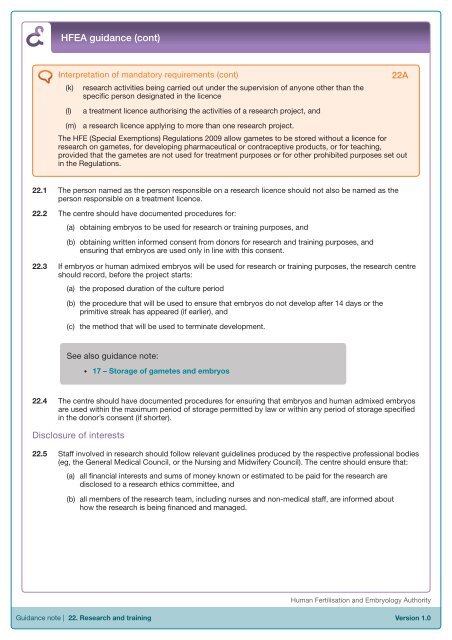Eighth Edition - R.3 - Human Fertilisation & Embryology Authority
Eighth Edition - R.3 - Human Fertilisation & Embryology Authority
Eighth Edition - R.3 - Human Fertilisation & Embryology Authority
You also want an ePaper? Increase the reach of your titles
YUMPU automatically turns print PDFs into web optimized ePapers that Google loves.
HFEA guidance (cont)<br />
Interpretation of mandatory requirements (cont)<br />
(k) research activities being carried out under the supervision of anyone other than the<br />
specific person designated in the licence<br />
22A<br />
(l)<br />
a treatment licence authorising the activities of a research project, and<br />
(m) a research licence applying to more than one research project.<br />
The HFE (Special Exemptions) Regulations 2009 allow gametes to be stored without a licence for<br />
research on gametes, for developing pharmaceutical or contraceptive products, or for teaching,<br />
provided that the gametes are not used for treatment purposes or for other prohibited purposes set out<br />
in the Regulations.<br />
22.1 The person named as the person responsible on a research licence should not also be named as the<br />
person responsible on a treatment licence.<br />
22.2 The centre should have documented procedures for:<br />
(a)<br />
obtaining embryos to be used for research or training purposes, and<br />
(b)<br />
obtaining written informed consent from donors for research and training purposes, and<br />
ensuring that embryos are used only in line with this consent.<br />
22.3 If embryos or human admixed embryos will be used for research or training purposes, the research centre<br />
should record, before the project starts:<br />
(a)<br />
the proposed duration of the culture period<br />
(b)<br />
(c)<br />
the procedure that will be used to ensure that embryos do not develop after 14 days or the<br />
primitive streak has appeared (if earlier), and<br />
the method that will be used to terminate development.<br />
See also guidance note:<br />
<br />
17 – Storage of gametes and embryos<br />
22.4 The centre should have documented procedures for ensuring that embryos and human admixed embryos<br />
are used within the maximum period of storage permitted by law or within any period of storage specified<br />
in the donor’s consent (if shorter).<br />
Disclosure of interests<br />
22.5 Staff involved in research should follow relevant guidelines produced by the respective professional bodies<br />
(eg, the General Medical Council, or the Nursing and Midwifery Council). The centre should ensure that:<br />
(a) all financial interests and sums of money known or estimated to be paid for the research are<br />
disclosed to a research ethics committee, and<br />
(b) all members of the research team, including nurses and non-medical staff, are informed about<br />
how the research is being financed and managed.<br />
<strong>Human</strong> <strong>Fertilisation</strong> and <strong>Embryology</strong> <strong>Authority</strong><br />
Guidance note | 22. Research and training<br />
Version 1.0

















